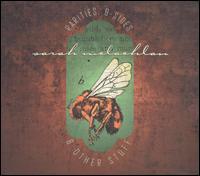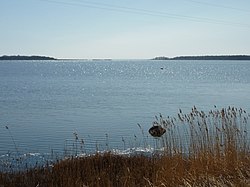HD 39194
HD 39194| 관찰 데이터 Epoch J2000.0EquinoxJ2000.0(ICRS) | |
|---|---|
| 콘스텔레이션 | 멘사 |
| 적경 | 05h 44m 31.9180s[1] |
| 적위 | - 70° 08° 36.858°[1] |
| 겉보기 등급(V) | 8.07±0.01[2] |
| 특성. | |
| 스펙트럼형 | K0 V[3] |
| U-B 색지수 | +0.26[4][5] |
| B-V 색지수 | +0.76[4][5] |
| 아스트로메트리 | |
| 반지름 속도(Rv) | 13.90±0[6].10km/s |
| 고유운동(μ) | RA: - 309.273 mas/yr[1] Dec.: +1238.862 밀리초/년[1] |
| 시차()) | 37.8235 ± 0.0206 mas[1] |
| 거리 | 86.23 ± 0.05 ly (26.44 ± 0.01 pc) |
| 절대 등급(MV) | +6.02[7] |
| 세부 사항 | |
| 덩어리 | 0.71[8] M☉ |
| 반지름 | 0.74[9] R☉ |
| 광도 | 0.389[10] L☉ |
| 표면 중력(log g) | 4.61±0[11].05kg |
| 온도 | 5,205±23[11] K |
| 금속성 [Fe/H] | - 0.61±0[11].02덱스 |
| 회전 속도(v sin i) | 2[12] km/s |
| 나이 | 11.7[8] Gyr |
| 기타 명칭 | |
| 데이터베이스 참조 | |
| 심바디 | 데이터. |
HD 39194(글리제 217.2, LHS 210)는 남쪽의 극성 둘레에 있는 항성이다.겉보기 등급은 8.07로 [2]쌍안경으로 쉽게 볼 수 있지만 육안으로는 볼 수 없다.이 물체는 86광년[1] 거리에서는 비교적 가깝지만 태양중심 반경 속도 13.9km/[6]s로 멀어지고 있다.
특성.
HD 39194의 일반적인 항성 분류는 K0 [3]V로 K형 주계열성임을 나타냅니다.Houk & Cowley는 G8 [13]V의 약간 따뜻한 클래스를 발견했고, 대신 G형 주계열성이 되었다.그럼에도 불구하고 태양 질량의[8] 71%에 유효 온도는 5,205 [11]K로 오렌지 색조를 띠고 있다.반지름 0.74☉[9] R의 [10]밝기는 태양의 38%에 불과하다.HD 39194는 117억 년 된 것으로[8] 추정되며 극도로 채색 활동이 [3]없다.행성이지만 철분 함유량은 태양의 [11]24%에 불과하다.HD 39194의 예상 회전 속도는 태양과 비슷하며 값은 [12]2km/s입니다.
행성계
이 별은 [9]2015년부터 외계행성의 후보로 선정되었습니다.7년간의 관측 후, 천문학자 팀은 HD 39194 [10]주위를 공전하는 3개의 슈퍼 지구를 발견했다; 어떤 행성도 거주 가능 지역에 있지 않다.HD 39194 b와 d의 질량은 비슷합니다.
| 동반자 (별부터 순서대로) | 덩어리 | 세미마조르 축 (AU) | 공전 주기 (일) | 편심 | 기울기 | 반지름 |
|---|---|---|---|---|---|---|
| b | ± 4.13±0.20🜨 M | 0.056±0.001 | 5.6368±0.0004 | 0.207 미만 | — | — |
| c | ± 6.29±0🜨.51M | 0.140±0.002 | 14.030±0.003 | 0.199 미만 | — | — |
| d | 4 4.13±0🜨.60M | 0.140±0.003 | 33.91±0.03 | 0.333 미만 | — | — |
「 」를 참조해 주세요.
레퍼런스
- ^ a b c d e Brown, A. G. A.; et al. (Gaia collaboration) (2021). "Gaia Early Data Release 3: Summary of the contents and survey properties". Astronomy & Astrophysics. 649: A1. arXiv:2012.01533. Bibcode:2021A&A...649A...1G. doi:10.1051/0004-6361/202039657. S2CID 227254300. (에라타: doi:10.1051/0004-6361/202039657e).VizieR에서 이 소스에 대한 Gaia EDR3 레코드.
- ^ a b Høg, E.; Fabricius, C.; Makarov, V. V.; Urban, S.; Corbin, T.; Wycoff, G.; Bastian, U.; Schwekendiek, P.; Wicenec, A. (March 2000). "The Tycho-2 catalogue of the 2.5 million brightest stars". Astronomy and Astrophysics. 355: L27–L30. Bibcode:2000A&A...355L..27H. ISSN 0004-6361.
- ^ a b c Gray, R. O.; Corbally, C. J.; Garrison, R. F.; McFadden, M. T.; Bubar, E. J.; McGahee, C. E.; O'Donoghue, A. A.; Knox, E. R. (2 June 2006). "Contributions to the Nearby Stars (NStars) Project: Spectroscopy of Stars Earlier than M0 within 40 pc--The Southern Sample". The Astronomical Journal. 132 (1): 161–170. arXiv:astro-ph/0603770. Bibcode:2006AJ....132..161G. doi:10.1086/504637. eISSN 1538-3881. ISSN 0004-6256.
- ^ a b Eggen, O. J. (January 1979). "Catalogs of proper-motion stars. I - Stars brighter than visual magnitude 15 and with annual proper motion of 1 arcsec or more". The Astrophysical Journal Supplement Series. 39: 89. Bibcode:1979ApJS...39...89E. doi:10.1086/190566. eISSN 1538-4365. ISSN 0067-0049.
- ^ a b Sandage, Allan; Fouts, Gary (January 1987). "New subdwarfs. VI - Kinematics of 1125 high-proper-motion stars and the collapse of the Galaxy". The Astronomical Journal. 93: 74. Bibcode:1987AJ.....93...74S. doi:10.1086/114291. ISSN 0004-6256.
- ^ a b Gontcharov, G. A. (November 2006). "Pulkovo Compilation of Radial Velocities for 35 495 Hipparcos stars in a common system". Astronomy Letters. 32 (11): 759–771. arXiv:1606.08053. Bibcode:2006AstL...32..759G. doi:10.1134/S1063773706110065. ISSN 1063-7737. S2CID 119231169.
- ^ Anderson, E.; Francis, Ch. (2012). "XHIP: An extended hipparcos compilation". Astronomy Letters. 38 (5): 331. arXiv:1108.4971. Bibcode:2012AstL...38..331A. doi:10.1134/S1063773712050015. S2CID 119257644.
- ^ a b c d Luck, R. Earle (13 February 2018). "Abundances in the Local Region. III. Southern F, G, and K Dwarfs". The Astronomical Journal. 155 (3): 111. Bibcode:2018AJ....155..111L. doi:10.3847/1538-3881/aaa9b5. eISSN 1538-3881.
- ^ a b c Margaret C Turnbull (2015). "ExoCat-1: The Nearby Stellar Systems Catalog for Exoplanet Imaging Missions". arXiv:1510.01731 [astro-ph.SR].
- ^ a b c d Unger, N.; et al. (October 2021). "The HARPS search for southern extra-solar planets". Astronomy & Astrophysics. 654: A104. arXiv:2108.10198. Bibcode:2021A&A...654A.104U. doi:10.1051/0004-6361/202141351. eISSN 1432-0746. ISSN 0004-6361.
- ^ a b c d e Sousa, S. G.; Santos, N. C.; Mayor, M.; Udry, S.; Casagrande, L.; Israelian, G.; Pepe, F.; Queloz, D.; Monteiro, M. J. P. F. G. (4 June 2008). "Spectroscopic parameters for 451 stars in the HARPS GTO planet search program". Astronomy & Astrophysics. 487 (1): 373–381. arXiv:0805.4826. Bibcode:2008A&A...487..373S. doi:10.1051/0004-6361:200809698. eISSN 1432-0746. ISSN 0004-6361.
- ^ a b Nordström, B.; Mayor, M.; Andersen, J.; Holmberg, J.; Pont, F.; Jørgensen, B. R.; Olsen, E. H.; Udry, S.; Mowlavi, N. (May 2004). "The Geneva-Copenhagen survey of the Solar neighbourhood: Ages, metallicities, and kinematic properties of ~14 000 F and G dwarfs". Astronomy & Astrophysics. 418 (3): 989–1019. arXiv:astro-ph/0405198. Bibcode:2004A&A...418..989N. doi:10.1051/0004-6361:20035959. ISSN 0004-6361.
- ^ Houk, N.; Cowley, A. P. (1975). University of Michigan Catalogue of two-dimensional spectral types for the HD stars. Volume I. Declinations -90° to -53.0°. Bibcode:1975mcts.book.....H.


